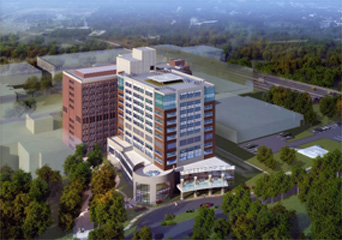 |
|
  |
|
|
MECHANICAL OPTION |
||
Thesis Proposal: |
Depth Study:
The district chilled water and steam plant of the INOVA Fairfax Hospital is reaching its design capacity with the addition of the South Patient Tower. To help solve this issue, a centralized cooling plant is being proposed to serve only the South Patient Tower loads. An investigation will be made into the design of a plant which will include; the type of chiller (absorption vs. electric compressor) and the pumping arrangement (primary-secondary vs. variable primary flow). The existence of high pressure steam supply to the building, the use of absorption chillers may prove to be the more efficient option limiting the use of electricity by the device. However, the cost of the steam generation may prove to be higher than that of purchasing electricity and the electric compression chiller may be the best choice. Once the most optimal system arrangement is selected, a further investigation into energy savings will be investigated. This will serve as both a technical study and an education study into chilled water plant design. These options include a heat recovery chiller and a condensate recovery system.
Breadth 1: Structural
The South Patient Tower's mechanical space is placed on the fifth floor of the building to help conserve space on the roof for a helipad. To help conserve this necessary roof space, it is being proposed to place the new chilled water plant in this mechanical space on the fifth floor. This will create various new structural loads that need to be adjusted. An investigation involving the calculations of the new loads into the structural concrete redesign is being proposed to mesh with the newly placed chilled water plant.
Breadth 2: Electrical
With the increased large equipment being added with the new chilled water plant redesign, the electrical load will be affected. To investigate the changes, a study will be done into the feeder sizes of the electrical system and resizing will occur for the new loads. The feeders will be resized from the fifth floor back to the building's main switchgear and a sizing calculation will be performed on all equipment that supplies this branch of the electrical system.
MAE Course Relation:
The requirement for the Master of Architectural Engineering program is the direct relation of the redesign to 500-level course studies. A major portion of the system redesign will be related to the AE 557, Centralized Cooling Production and Distribution Systems subject matter. The course centers on the comparison between various cooling plant equipment and the primary/secondary pumping and variable primary flow arrangements, as well as discussing the benefits and downfalls of each system.
| Senior Thesis | Penn State Home | Architectural Engineering | AE Computer Website | Contact |
|
Last Updated:
1/12/12
by Michael Morder Website is hosted by the AE Department ©2011/2012 |
|||